COLUMNS
360º Architecture
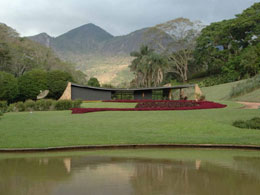
27 May, 2011
Roberto Burle Marx: The Marvellous Art of Landscape Design
Αn exhibition currently on show at the Cité de l'architecture et du patrimoine, in Paris.
Roberto Burle Marx : La Permanence de l'instable, an exhibition currently on show at the Cité de l'architecture et du patrimoine, in Paris (23 March - 24 July 2011), celebrates the work of one of the greatest landscape architects of the twentieth century.
Heitor Villa-Lobos's Bachianas Brasileiras, a series of nine suites composed between 1930 and 1945, brought together Johann Sebastian Bach with the Baianas - African women of Bahia - some of whom made their way to Rio de Janeiro following the abolition of slavery and played a key role in the development of samba music and dance. Villa-Lobos also tried composing melodies on the outlines of the mountains of the Serra da Piedade in the state of Minas Gerais (Melodia da montanha, 1938). Tongue-in-cheek, Brazil's erudite national composer told the Parisian press in the 1920s that 'his genuinely indigenous melodies had been jotted down by him in the middle of the Amazon jungle, when he was on the point of being devoured by singing, dancing cannibals'.(1) Villa-Lobos's ironic acknowledgment of the Parisian audience's appreciation of the exotic, primitive or savage sonorities of his innovative pieces - where syncopated Afro-Brazilian rhythms meet Debussy's tonal scale (Três danças africanas, 1914-16) - was not meant to serve the interests of his European admirers, hunting for authentic musical experiences. It indicated, instead, that his musical explorations followed what Slavoj Žižek describes as 'the opposite process, in which something that was originally an ideological edifice imposed by colonizers is all of a sudden taken over by their subjects as a means to articulate their "authentic" grievances'.(2)
One of the protagonists of the 'collective manifesto' of Brazilian Modernism, the Semana de Arte Moderna in São Paulo (11-17 February 1922),(3) Villa-Lobos employed Oswald de Andrade's method of cultural cannibalism to critically appropriate and assimilate diverse African, indigenous and Western influences - erudite and popular - while also turning imposed ideology into a symbol of resistance to hegemonic models. Villa-Lobos' 'singing, dancing cannibals' are not the docile 'noble savages' of European colonizers, but the irreverent, anticolonialist cannibals of Brazil's twentieth-century Modernism. Launched in 1928 by the poet Oswald de Andrade (with Raúl Bopp and Antônio de Alcântara Machado), author of the two most important manifestos of Brazilian Modernism, the Movimento Antropofágico appropriated the European and Eurocentric concept of cannibalism - associated with the natives of America and the Caribbean, and used as ideological justification for colonization and exploitation - radicalized that which the Europeans most feared and hated, and transformed it into a powerful instrument of artistic and cultural emancipation. Antropofagia inaugurated one of the most fertile and most irreverent periods of Brazilian culture. Adopted by artists across a large spectrum of media, from literature to painting and from cinema to architecture, it offered Brazilian Modernists a strategy to appropriate, infect and thus re-invent colonizing cultural imports with the Brazilianizing 'cannibalistic vaccine'.(4) Rather than being devoured by the cannibals of European thought and remain deaf to the sounds of the Amazon, Villa-Lobos used the sounds of the Brazilian jungle to contaminate Europe's civilizing melodies. The Brazilian Modernists' desire to question the European binary model of civilization versus savagery, challenge the hegemony of European catechizing traditions, and firmly root their art in Brazilian soil found its literal expression in the work of the landscape architect Roberto Burle Marx (1909-94).
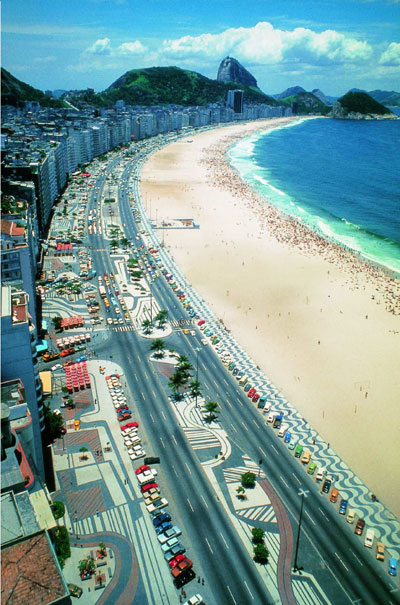
Roberto Burle Marx, mosaic pavements (calçadões) along Avenida Atlântica, Copacabana Beach, Rio de Janeiro, 1969-72, photograph of circa 1975, source: Escritório Burle Marx
Perhaps the most celebrated feature of Rio de Janeiro's legendary Copacabana Beach is its elegant mosaic pavements. During the construction and urbanization of Avenida Atlântica (1905-06), along Copacabana's curved, sandy beach, Mayor Francisco Pereira Passos imported both skilled craftsmen and stone from Portugal to pave the oceanfront promenade. The Portuguese artisans followed patterns typical of the distinctive paving of Portuguese walkways (calçada à portuguesa), entirely covered in alternating black-and-white waves composed of small stones cut and laid by hand. In his project for the renovation and extension of the pavements of Avenida Atlântica (Calçadão de Copacabana, 1969-72), Burle Marx retained the original pattern on the beachfront pavement - only accentuating the curves - preserving the memory of the colonial metropolis.(5) For the new pavements on the opposite side of the seafront and on the islands at the centre of the avenue, however, he used the same black and white stones combined with a red one to compose a magnificent four-kilometre-long abstract mosaic that pays tribute to the colonial artisan tradition - the old motif at times reappears in the form of fragmentary quotations - and imaginatively re-invents. Burle Marx's juxtaposition of the old and new mosaic pavements along Avenida Atlântica constitutes one of the most eloquent expressions of his lifelong ambition to elevate landscape design to the level of the fine arts.
At the Amazon port of Manaus, the Praça São Sebastião in front of the extravagant Teatro Amazonas (1893-96) is also paved with black-and-white flowing curves in pedra portuguesa. Just like Cariocas interpret Copacabana's original pavement patterns as an allusion to the waves of the ocean, the citizens of Manaus allege that the sinuous black-and-white stripes of their city's emblematic public space refer to the Amazonian riverscape, more specifically, to the confluence of the mineral-deficient black currents of Rio Negro with the silt-laden waters of Rio Solimões. Popular imagination did not take long to discover in Burle Marx's abstract Copacabana mosaics a reference to Brazil's celebrated racial confluence, at the centre of twentieth-century definitions of Brazilian national identity.(6) The red, black and white stones are regarded as symbolic of the three 'races' that have shaped Brazilian culture. In a further ingenious Brazilianizing ingestion of the Portuguese pavement stonework, on the large lawn of Affonso Eduardo Reidy's Museum of Modern Art (Aterro do Flamengo, Rio de Janeiro, 1959-63), Burle Marx re-created the familiar wavy pattern using two different colours of Stenotaphrum secundatum grass. The tropicalized Portuguese import now literally grows on Brazilian soil, symbolically uniting Brazil's natural emblems: the biggest river in the world, the ocean and her most beautiful flora. The Aterro do Flamengo, built on reclaimed seafront, is Rio's largest urban park and one of Burle Marx's most important projects, both in terms of design and as an ingenious ecological experiment. It is also one of the projects that exemplify his understanding of the social role and democratizing function of public gardens in the modern city.

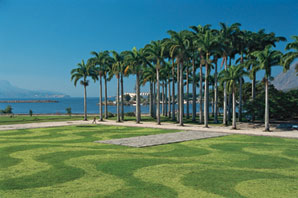
Roberto Burle Marx, detail of beachfront mosaic pavement along Avenida Atlântica (renovation of early twentieth-century calçada à portuguesa), Copacabana Beach, Rio de Janeiro, 1969-72: left; lawn of the Museum of Modern Art with two different colours of Stenotaphrum secundatum grass, Aterro do Flamengo, Rio de Janeiro, 1959-63: right. Photographs by Styliane Philippou
Trained in music and painting, Burle Marx considered himself primarily a painter and dedicated to painting every morning before attending to his design practice. But the painter's work extended well beyond the conventional canvas, for Burle Marx, who used to say that he 'paint[ed] [his] gardens'. Although undoubtedly his greatest legacy is his highly innovative, hugely influential and immensely pleasurable public urban spaces, parks and private gardens - in Brazil and throughout the world, from Caracas to Kuala Lumpur - Burle Marx was a truly multi-faceted and hugely prolific artist, able to exploit the possibilities inherent in an extraordinary variety of media. He created etchings and engravings, sculptures and ceramics, monumental azulejo mosaics, gorgeous tapestries, stage sets and costumes, stunning jewellery, various objects such as hand-painted tablecloths and ephemeral decorative sculptures that graced his legendary banquets, stupendous floral arrangements and a great deal more.
His investigations in one medium often fed into his practice in another, and he frequently explored ideas and questions of form through a variety of artistic media, before proceeding to address questions directly relating to the material expression of his ideas in a particular landscape project. He moved easily from one creative domain to another, his landscape design methods were often influenced by his experiments with new techniques in other areas such as painting, weaving or fabric dying, and he often integrated his own artworks in his landscape projects. No scholar wishing to analyse and elucidate Burle Marx's contribution to the art of landscape design could afford to ignore the daring artistic experiments and insights that nurtured the designer's bold visions and remarkable discoveries. And no attempt to begin to understand Burle Marx's sophisticated design process and to capture the astounding complexity of the ideas embedded in his landscape projects could advance beyond general descriptions and commonplace assertions without engaging with the wider context of Brazilian cultural practice in the first half of the twentieth century. For Burle Marx's thought and practice are intimately linked with the Modernist construction of Brazil's national identity, and his enchanting landscapes have had an enduring influence on the creation of the modern image of Brazil.
A self-taught botanist and expert horticulturist with several species named after him, Burle Marx travelled indefatigably and until an old age, throughout Brazil and in South and Central Asia, observing plants in their natural habitats and searching for new species for his tropical gardens. At his laboratory, the Sítio Santo Antônio da Bica in Barra de Guaratiba (1949-), he collected more than 3,500 different species, and grew, studied and multiplied himself the plants he used in his projects. Burle Marx's expeditions and plant discoveries contributed in a very literal way to the Brazilian Modernists' second discovery of Brazil aimed to define the ingredients of brasilidade (Brazilianness) and to achieve cultural emancipation. Although he frequently combined native flora with plants from tropical regions outside Brazil and even with species form temperate zones, for Burle Marx, native Brazilian plants represented both a natural and a national heritage.
In 1965 the American Institute of Architects (AIA) awarded Burle Marx its fine-arts prize, recognizing him as 'the real creator of the modern garden', and thus acknowledging the value and influence of his work beyond the limits of Brazil. In 1991, the Museum of Modern Art (MoMA) in New York dedicated to him its first exhibition on a landscape architect (Roberto Burle Marx: The Unnatural Art of the Garden). For Burle Marx, the creation of a garden was 'a marvellous art - possibly one of the oldest manifestations of art' - as well as an attempt to 'regain [a] lost paradise'.(7) Although he did not shy away from creating what he called 'artificial ecological associations' in his gardens and urban parks, he also considered the modern garden as 'the place to display, conserve and perpetuate the existence of native species otherwise threatened in the wild'.(8) Beginning in the late 1960s, he raised his voice against the destruction of the Amazon forest, and in the early 1990s he criticized Rio's steady retreat behind walls and campaigned against the enclosure of city parks behind iron fences, which would amount, he said, to 'Rio in a cage'.
Burle Marx's deep understanding of plants and living systems, and his continuous research in the qualities of plants and their 'constant mutation', led him to grapple with the fundamental question of time and instability in relation to the art of creating a garden. As Rossana Vaccarino has argued, Burle Marx turned time and instability into subjects for exploration and artistic expression. 'Plants are living so long as they undergo changes,' observed Burle Marx, and he endeavoured to achieve in his gardens a similar condition of 'constant mutation, permanent imbalance, the purpose of which is a quest for balance'. He understood the creation of a garden as a long and slow process involving creative discovery, best pursued in phases and necessitating the designer's continuous in-situ editing in parallel with natural growth and seasonal change. Burle Marx designed for permanent instability, a sort of controlled constant change, which he saw as a necessary condition for the preservation of the garden as a living system. It is precisely this 'ability to evolve, respond, and adapt creatively to changing circumstances and sudden disturbance' that Vaccarino recognizes in Burle Marx's most successful gardens, like the one of Fazenda Marambaia in Correias (Odette and Julio Monteiro residence, Petrópolis, Rio de Janeiro state, 1946-51) and Fazenda Vargem Grande in Areias (Clemente Gomes residence, São Paulo state, 1979-89, incomplete).(9) The same qualities characterize a third large private garden Burle Marx created for Edmundo Cavanelas in Pedro do Rio, which conspires with the surrounding landscape to produce a unique setting for the holiday house designed by Oscar Niemeyer (Petrópolis, Rio de Janeiro state, 1954). Howard Adams observes that Burle Marx's painterly gardens 'effect a "bifurcation" of the viewer's perceptions between the plant specimen close at hand and the distant vista'.(10) The Cavanelas gardens present a stunning example of this effect.
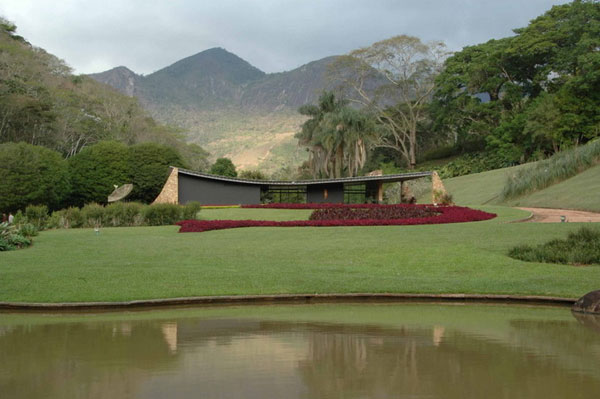
Roberto Burle Marx, garden of Edmundo Cavanelas House by Oscar Niemeyer, Pedro do Rio, Rio de Janeiro state, 1954. Photograph by Styliane Philippou
Born in São Paulo, Burle Marx grew up in Rio de Janeiro, in a former plantation house on rua Araújo Gondim, at the end of Copacabana Beach known as Leme. In 1932, his experimental garden beds attracted the attention of Lúcio Costa, his neighbour and former tutor at the Escola Nacional de Belas Artes (ENBA), who invited him to design the garden of the Alfredo Schwartz House in Copacabana (1932, demolished). The house itself was designed by Costa and Gregori Warchavchik, the creator of Brazil's first garden terraces in the 1920s. For the Paulista pioneer of architectural Modernism in Brazil, whose gardens of cacti and palms (designed by Gregori's wife, Mina Klabin Segall Warchavchik) had been praised by the Modernist poet Mário de Andrade, tropical flora was a complement to the new architecture in the way plaster mouldings were to the architecture of the past. With Burle Marx, Brazilian Modernism advanced well beyond the idea of a garden as a mere complement to the architecture.
Burle Marx's gardens are an essential part of the architectural project. The tropical gardens he created for Niemeyer's pioneering group of buildings at Pampulha (Belo Horizonte, 1940-43), for example, amplify the architectural call to hedonism and useless sensual pleasure, becoming emblematic of Niemeyer's transgression into forbidden territories beyond the boundaries of the functionalist utopia. As Bernard Tschumi noted in 1977, 'built exclusively for delight, gardens are like the earliest experiments in that part of architecture that is so difficult to express with words or drawings; pleasure and eroticism. Whether romantic or classical, gardens merge the sensual pleasure of space with the pleasure of reason, in a most useless manner.'(11) In Brazil, Burle Marx's Modernist gardens invoke, appropriate and radicalize the visions of the Garden of Eden inspired by the discovery of the country by the Portuguese, the milieu of Michel de Montaigne's ideal republic of the native Indians of Brazil, 'a nation' with 'no occupation but that of idleness'.(12) Recalling Villa-Lobos's 'singing, dancing cannibals', Burle Marx's modern paradisiacal tropical gardens took over what 'was originally an ideological edifice imposed by colonizers' and turned it into a means to subvert catechizing architectural discourses, exceed rationalist decorum and overcome the puritanical denunciation of pleasure.
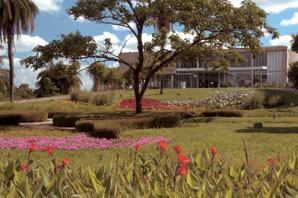
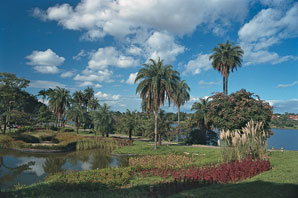
Roberto Burle Marx, garden of Casino by Oscar Niemeyer, Pampulha, Belo Horizonte, Minas Gerais, 1940-43. Photographs by Styliane Philippou
Few years after their first collaboration, Costa commissioned Burle Marx to design the gardens of the Ministry of Education and Public Health building (Lúcio Costa, Oscar Niemeyer, Carlos Leão, Affonso Eduardo Reidy, Jorge Moreira and Ernani Vasconcellos, with Le Corbusier acting as a consultant in 1936, Rio de Janeiro, 1936-44), the first state-sponsored Modernist skyscraper in the world and the architectural manifesto of Brazilian modernity. Burle Marx was responsible for some of the most transgressive elements of Brazil's seminal modern monument: decolonized, 'open-ended' tropical gardens of pleasure, dominated by the sensuous curves of the Brazilian landscape. This was the first garden for which Burle Marx used an abstract painting as a design tool. He employed the same method at contemporaneous projects for the Associação Brasileira de Imprensa (ABI, Brazilian Press Association Headquarters), designed by Marcelo, Milton and Maurício Roberto (1936-38), and, most significantly, for Brazil's twentieth-century front door, Rio de Janeiro's Santos Dumont Airport, designed in 1937, again by the Roberto brothers.
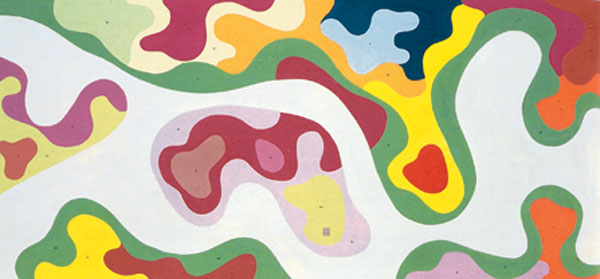
Roberto Burle Marx, gouache painting for the minister's rooftop garden (1938), Ministry of Education and Public Health, Rio de Janeiro, 1936-44, source: Escritório Burle Marx
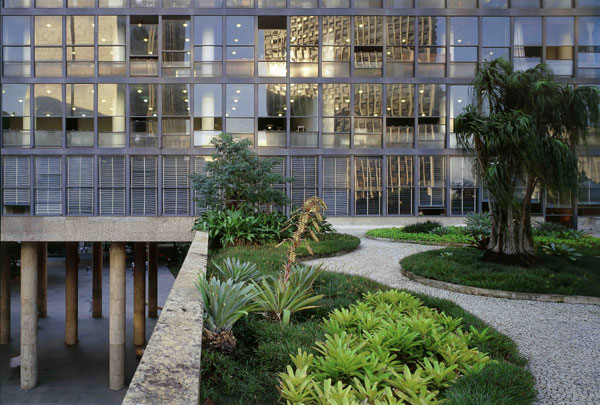
Roberto Burle Marx, jardin suspendu, Ministry of Education and Public Health, Rio de Janeiro, 1938-44. Photograph by Nelson Kon
In 1947, 'looking up at the building from below', towards the minister's jardin suspendu, Claude Vincent of the Architectural Review had 'the mysterious feeling of some strange jungle rising fantastically into the sky and bringing the rain clouds down to the level of the two blue funnels which enclose the lift shafts and the water cisterns of what is still the most beautiful skyscraper in Rio'.(13) An aerial view of the minister's rooftop garden bespeaks more clearly Burle Marx's irreverent, antropofagist strategy. Valerie Fraser suggests that this garden, which resembles an aerial view of a tropical wetland landscape, may have been inspired by Le Corbusier's lyrical description of the views that fascinated him during his 1929 flight over Argentina, especially those of the meanders of the Paraná and Paraguay rivers 'in these endless flat plains'. In Précisions, Le Corbusier repeatedly employed the image of sinuous river curves as a metaphor for 'the incoherent loops of the meanders of an outworn civilization', against which is directed the rationality of the 'machine age'.(14) Fraser offers a convincing reading of the 'meandering anarchy of Burle Marx's design as a...deliberate celebration of the irrational meander coexisting with the straight lines of Le Corbusian modernity'.(15) Unfortunately, following a modification of the garden in the 1970s, much of the original river-bank effect was lost. Around the planted amoebae, Burle Marx's original scheme had featured organically curved areas in stones of various colours and textures - like highly polished white marble and textured green jade - sadly, all replaced by white limestone (pedra portuguesa).
The Ministry of Education and some of the other projects on which Burle Marx collaborated with almost all the architects of Brazilian Modernism (Oscar Niemeyer, Affonso Eduardo Reidy, Jorge Machado Moreira, Olavo Redig de Campos etc.) are represented in an exhibition currently hosted at the Cité de l'architecture et du patrimoine, in Paris (Roberto Burle Marx : La Permanence de l'instable), which runs through to 24 July. This is a much truncated version of a retrospective held at the Museo do Paço Imperial, in Rio de Janeiro, to mark the centenary of Burle Marx's birth (Roberto Burle Marx: a permanência do instavel, 100 anos, January - March 2009, curated by Lauro Cavalcanti) and later shown at the Museu de Arte Moderna in São Paulo, and at the Brazilian Embassy in Berlin (reduced versions). The Parisian show offers no such splendours as the Paço Imperial's open patio with vertical planters, a typical Burle Marx device. But it is also deprived of most of the original exhibition's artworks: scores of canvases, tapestries (including a twenty-six-metre-long one), sculptures, models etc. For those familiar with Burle Marx's work it is a delight to stand before the vibrant colours of the original gouache for the roof garden of the Ministry of Education, the sketches for the gardens of cacti and Amazonian water lilies that he designed as director of parks at Recife (1934-36), or his paintings for the building patios at the UNESCO Headquarters in Paris (Marcel Beuer, Pier Luigi Nervi and Bernard Zehrfuss 1958-63) and the drawings for the unrealized rooftop garden of the Centre Pompidou (1988). But this selective display of largely unconnected drawings, photographs, few paintings, stage-design renderings etc. is unlikely to enlighten spectators who encounter the work of Burle Marx for the first time. As for the initiated, they are bound to feel that this limited and fragmentary display of snapshots from Burle Marx's extraordinary and vast body of work - a kind of resurrection pie made up of the leftovers of Rio's show - fails to do justice to his remarkable achievements and provoke reflection.
It is superfluous to repeat here that no museum exhibition could ever represent the true qualities of gardens and urban public spaces, let alone replace the viewer's experience of these spaces. Exhibiting architecture or landscape architecture within a museum setting is notoriously difficult, primarily because the product of the work of the architect or the landscape designer cannot be exhibited in the same way as other artworks can, and curatorial practice in architecture is a relatively new field. Curators of such shows try to give a comprehensive tour of the architect's career focusing on key projects, grant an insight into the architect's creative process by exposing to the public their working tools, for example, or, according to Francesco Dal Co, they try to tell the complex story of each project.
At the Cité de l'architecture, the viewer who expects a scholarly recapitulation of Burle Marx's oeuvre, mapping out his various artistic endeavours and the points of fertile intersection, will be disappointed. Visitors are offered no help to navigate what appears like a haphazard selection of rather limited material, no indication of the relation between paintings and landscape projects, no clues to the story of each project or pointers to the big picture. As one would expect at a retrospective of this kind, the minimal text is highly hagiographic. But it neither instructs nor begins to analyze and interpret, and hence fails to convince and stimulate further thought. It also contains inadequate, erroneous, contradictory or misleading factual information (for example, with regard to Burle Marx's input in Lúcio Costa's pilot plan for Brasília, or when it describes 'the Ministry of Education [as] the result of the collaboration between, notably, Le Corbusier and Lúcio Costa'). Major projects are absent, seriously underrepresented or poorly described.
Most disappointingly, the exhibition makes no attempt to situate Burle Marx's work in its historical and cultural context, entirely bypasses its crucial role in Brazilian architecture's pioneering critique of canonical Modernist dogma and moralizing ideologies, and pays no attention to the contemporary relevance and importance of his contribution to the art of landscape design. For an exhibition devoted to a landscape architect whose most original projects coincided with the defining period of modern landscape architecture, and whose novel aesthetic principles and revolutionary pratice radically altered its subsequent history and its relationship to architecture and the city, these are major omissions. The title of the show sounds profound, but its meaning remains concealed. An en passant reference at the closing of an introductory text by the director of the French Institute of Architecture, Francis Rambert, is of little help. Despite Rambert's assertion, it certainly does not reflect 'the main theme of this major retrospective'. In fact the exhibition at the Parisian Cité de l'architecture lacks a clear focus, which would have helped guide the selection of material from the original retrospective. Burle Marx's adventurous artistic career and his groundbreaking and far-reaching innovations in the art of landscape design deserve a more complete and better exhibition.
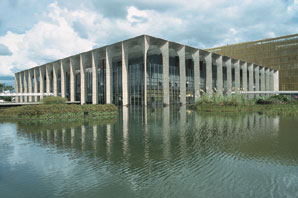
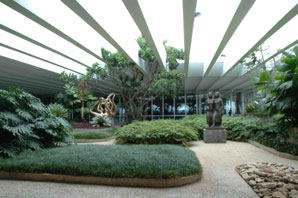
Palácio do Itamaraty (Ministry of Foreign Affairs) designed by Oscar Niemeyer, Brasília, 1962-70: view of the main pavilion set in a pool landscaped by Roberto Burle Marx, left; view of Burle Marx's rooftop garden, right. This was the first time Burle Marx was invited to work in Brasília, by the minister of foreign affairs, Vladimir Murtinho. Photographs by Styliane Philippou
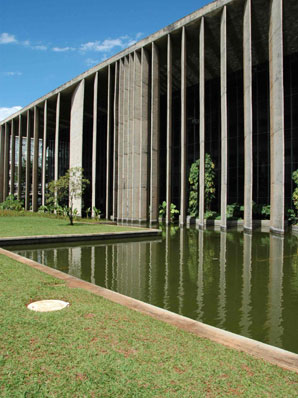
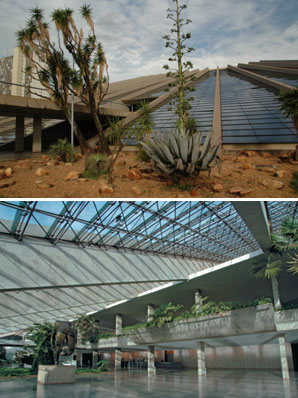
Ministry of Justice, Brasília, designed by Oscar Niemeyer, 1962-70 (modified 1986): view of the main pavilion (west elevation) set in a pool landscaped by Roberto Burle Marx, left. National Theatre, Brasília, designed by Oscar Niemeyer, 1958-81: Roberto Burle Marx's gardens of cacti and other succulent plants pay homage to the flora of the caatinga, Brazil's arid region of the Northeast, right top; view of foyer with Burle Marx's tropical gardens, right bottom. Photographs by Styliane Philippou
Notes
1 José Miguel Wisnik, 2000, 'Antropofagia and Music'. In Brasil 1920-1950: De la Antropofagia a Brasília, ed. Jorge Schwartz (Valencia: IVAM, VEGAP, exhibition catalogue, bilingual edition), pp. 557-58.
2 Žižek, Slavoj, 2006, The Parallax View (Cambridge, Massachusetts: The MIT Press), p. 234.
3 Andrade, Mário de, 2000, 'The Modernist Movement' (lecture delivered in 1942, originally published in Aspectos da Literatura brasileira (São Paulo: Martins), pp. 231-55). In Brasil 1920-1950: De la Antropofagia a Brasília, p. 593.
4 See Philippou, Styliane, 2004, 'The Primitive as an Instrument of Subversion in Twentieth-Century Brazilian Cultural Practice', arq: Architectural Research Quarterly 8, nos 3-4, pp. 285-98.
5 Roberto Burle Marx had already used the Portuguese black-and-white pavement pattern in his designs for the Terrero de Jesus (1952) and the Praça Três de Maio (1954, renovation) in Salvador, Bahia, and for the Largo do Machado (1954) in Rio de Janeiro.
6 See Philippou, Styliane, 2005, 'Modernism and National Identity in Brazil or How to Brew a Brazilian Stew', National Identities 7, no. 3, pp. 245-64.
7 Burle Marx, Roberto, 1991, 'Foreword'. In Sima Eliovson, The Gardens of Roberto Burle Marx (Portland, Oregon: Timber Press), p. 7.
8 Quoted in Vaccarino, Rossana, 2000, 'Introduction'. In Roberto Burle Marx: Landscapes Reflected, ed. Rossana Vaccarino (New York: Princeton Architectural Press), p. 8.
9 Vaccarino, Rossana, 2000, 'The Correspondence of Time and Instability'. In Roberto Burle Marx: Landscapes Reflected, p. 44. See also: Vaccarino, Rossana, 2002, 'Interpreting and Preserving the Work of Roberto Burle Marx: In Search for New Approaches', Paisagem e Ambiente, 16, http://www.revistasusp.sibi.usp.br/scielo.php?pid=S0104-60982002000300002&script=sci_arttext
10 Howard Adams, quoted in Treib, Marc, 1993, 'Axioms for a Modern Landscape Architecture'. In Modern Landscape Architecture: A Critical Review, ed. Marc Treib (Cambridge, Massachusetts, and London: MIT Press), p. 53.
11 Tschumi, Bernard, 1996, Architecture and Disjunction (Cambridge, Massachusetts, and London: MIT Press), p. 86.
12 Montaigne, Michel de, 1999, 'Of the Cannibals' (1580 in French). In The Utopia Reader, ed. Gregory Claeys and Lyman Tower Sargent (New York and London: New York University Press), p. 100. In their idyllic world, Montaigne noted, 'the whole day is spent in dancing'; Montaigne, p. 101.
13 Vincent, Claude, 1947, 'The Modern Garden in Brazil', Architectural Review 101, no. 605 (May), p. 172.
14 Le Corbusier, 1991, Precisions: On the Present State of Architecture and City Planning (Cambridge, Massachusetts, and London: MIT Press), pp. 4, 17, 154.
15 Fraser, 2000, 'Cannibalizing Le Corbusier: The MES Gardens of Roberto Burle Marx', Journal of the Society of Architectural Historians 59, no. 2 (June), pp. 180-93, quotation on p. 189.
Related articles:
- 360 Degrees Architecture ( 10 October, 2009 )
- Τhe Roots of the Industry of the Image ( 27 October, 2009 )
- Anish Kapoor: Non-objective Objects ( 26 November, 2009 )
- Love Thy Planet ( 28 December, 2009 )
- Europe’s Civilization under Threat ( 28 January, 2010 )
- Made of Stone and Water, for the Human Body ( 28 February, 2010 )
- Bokja: ‘A Woman’s Affair’ ( 28 March, 2010 )
- Brasília from the Beginning, Fifty Years Ago ( 07 April, 2010 )
- Brasília, ‘capital of the highways and skyways’ ( 30 April, 2010 )
- Oscar Niemeyer’s Permanent International Fair in Tripoli ( 29 May, 2010 )
- Learning from Miami ( 10 July, 2010 )
- The Greatest Show on the Beach ( 08 August, 2010 )
- Oscar Niemeyer: Curves of Irreverence ( 28 March, 2011 )
- The Lizards of Djenné ( 26 September, 2010 )
- Transformed by Couture ( 29 October, 2010 )
- Another Athens Is Possible ( 02 December, 2010 )
- From Juan O’Gorman for Diego Rivera and Frida Kahlo ( 28 February, 2011 )
- The Danger that Lurks on this Side of the Gates ( 10 September, 2011 )
- Eduardo Souto de Moura ( 21 November, 2011 )










